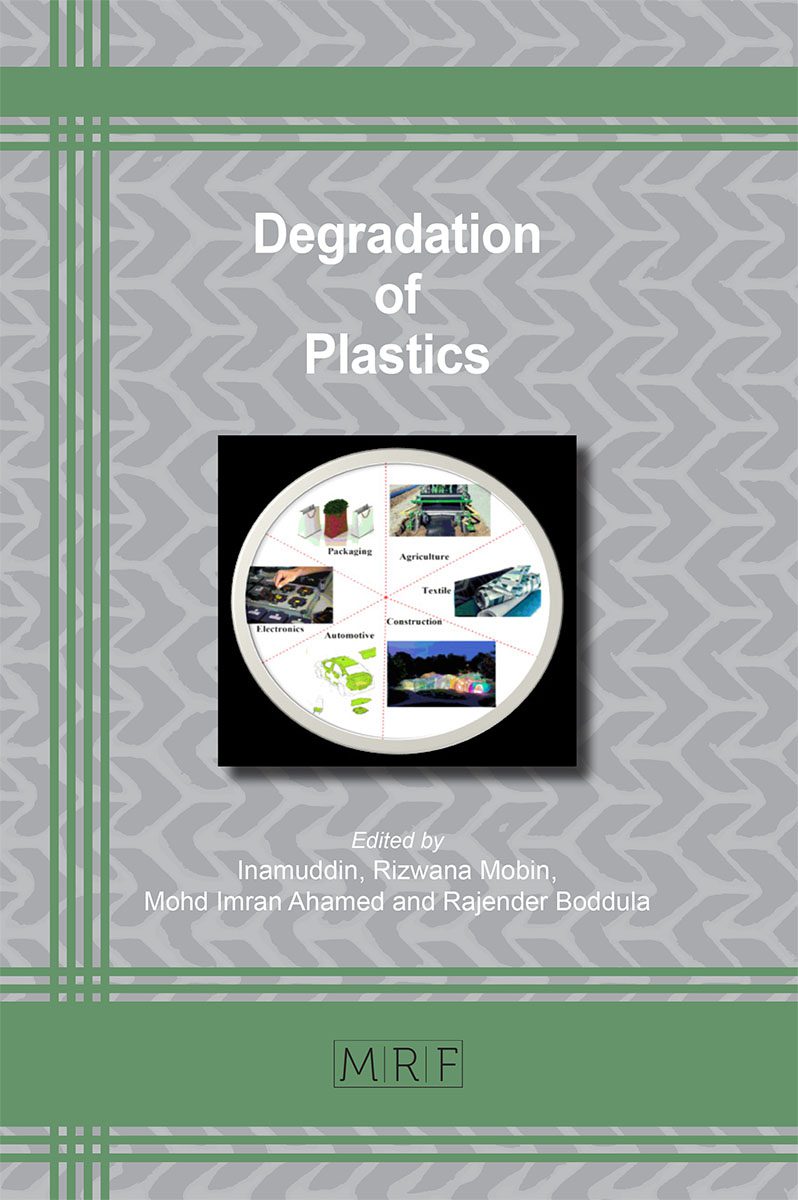Degradable Plastic Recycling
Nadia Akram, Khalid Mahmood Zia, Asim Mansha
The public demand of plastics for food, drinks, consumable and packaging is increasing enormously all over the world. Due to limited available plastic resources, it is challenging to meet the stipulation of the massive population. The contribution of the synthetic plastic industry is encouraging to cope with these challenges. However, it is not only restricted towards production, but the degradation of its waste is also equally arduous and even more complicated to a large extent. A useful solution to this problem is recycling instead of degradation. In order to optimize the utility of recycling, various techniques are in progress. Plastic recycling is an acceptable technique to keep the economy in circulation. Moreover, it is an effective way to reduce the environmental pollution and to promote green environment.
Keywords
Plastic Industry, Global Warming, Economy Circulation, Environment, Reusability
Published online 4/1/2021, 14 pages
Citation: Nadia Akram, Khalid Mahmood Zia, Asim Mansha, Degradable Plastic Recycling, Materials Research Foundations, Vol. 99, pp 81-94, 2021
DOI: https://doi.org/10.21741/9781644901335-3
Part of the book on Degradation of Plastics
References
[1] P. Anastas, J. Zimmerman, Design through the twelve principles of green engineering, Environ. Sci. Technol. 37 (2003) 94A–101A. https://doi.org/10.1021/es032373g
[2] G. Atkinson, K. Hamilton. Savings, growth, and the resource cure hypothesis. World. Dev. 31 (2003) 1893–1807. https://doi.org/10.1016/j.worlddev.2003.05.001
[3] F. Esteves, J. Santos, P. Anunciacao, Sustainability in the information society a proposal of information systems requirements in view of the DPOBE model for organizational sustainability. Procedia. Technol. 5 (2012) 599–606. https://doi.org/10.1016/j.protcy.2012.09.066
[4] F. Granek, M. Hassanali. The toronto region sustainability program insights on the adoption of pollution prevention practices by small to medium-sized manufacturers in the Greater Toronto Area (GTA). J. Clean. Prod. 14 (2006) 572–579. https://doi.org/10.1016/j.jclepro.2005.07.008
[5] A Kulig, H. Kolfoort, R. Hoekstra, The case for the hybrid capital approach for the measurement of the welfare and sustainability. Ecol. Indic. 10 (2010) 118–128. https://doi.org/10.1016/j.ecolind.2009.07.014
[6] W.McDonough, M.Braungart, P.T. Anastas, J.B. Zimmerman. Applying the principles of green engineering to cradle-to-cradle design. Environ. Sci. Technol. 37 (2003) 434A–441A. https://doi.org/10.1021/es0326322
[7] L. White, B. Noble. Strategic environmental assessment for sustainability, A review of a decade of academic research. Environ. Impact Assess. Rev. (2013)4260–66. https://doi.org/10.1016/j.eiar.2012.10.003
[8] H. Beltrami, E. Bourlon. Ground waring patterns in the Northern Hemisphere during the last five centuries. Earth Planet. Sci. Lett. 227 (2004) 169–177. https://doi.org/10.1016/j.epsl.2004.09.014
[9] E. Berthier, Y. Arnaud, R. Kumar, S. Ahmad, P. Wagnon, P. Chevallier. Remote sensing estimates of glacier mass balances in the Himachal Pradesh (Western Himalaya, India). Remote. Sens. Environ. 108 (2007) 27–338. https://doi.org/10.1016/j.rse.2006.11.017
[10] E. J.Carpenter, K. L. Smith Jr. Plastics on the Sargasso Sea surface. J. Sci 175 (1972) 1240–1241. https://doi.org/10.1126/science.175.4027.1240.
[11] E. Carpenter, S. Anderson, G. Harvey, H. Miklas, B. Peck. Polystyrene spherules in coastal waters. J. Sci. 178 (1972) 749–750. https://doi.org/10.1126/science.178.4062.749
[12] A. Cazenave, A. Lombard, W. Llovel. Present-day sea level rise: A synthesisHausse actuelle du niveau de la mer: synthèse .340 (2008) 761–770. https://doi.org/10.1016/j.crte.2008.07.008
[13] M. Akiyama, T. Tsuge, Y. Doi. Environmental life cycle comparison of polyhydroxyalkanoates produced from renewable carbon resources by bacterial fermentation. Polym. Degrad. Stabil. 80 (2003) 183–194. https://doi.org/10.1016/S0141-3910(02)00400-7
[14] F. Aouada, L. Mattoso, E. Longo. New strategies in the preparation of exfoliated thermoplastic starch–montmorillonite nanocomposites. Ind. Crops.Prod. 34 (2011). 1502–1508. https://doi.org/10.1016/j.indcrop.2011.05.003
[15] P. Bordes, E. Pollet, L. Avernous. Nano-biocomposites biodegradable polyester/nanoclay systems. Prog. Polym.Sci. 34 (2009) 125–134. https://doi.org/10.1016/j.progpolymsci.2008.10.002
[16] J. Greene. PHA biodegradable blow-molded bottles compounding and performance. Plast. Eng. 69 (2013) 16–21. https://doi.org/10.1002/j.1941-9635.2013.tb00940.x
[17] K. Hofvendahl, B. Hahn-Hagerdal. Factor affecting the formative lactic acid production from renewable resources. Enzyme. Microb. Technol. 26 (2000) 87–107. https://doi.org/10.1016/s0141-0229(99)00155-6
[18] K. Kim, S. Woo. Synthesis of high molecular weight poly (L-lactic acid) by direct polycondensation. Macromol. Chem. Phys. 203 (2002) 2245–2250. https://doi.org/10.1002/1521-3935(200211)203:15<2245::AID-MACP2245>3.0.CO;2-3
[19] D. Kint, S. Munoz-Guerra. A review on the potential biodegradability of poly(ethylene terephthalate. Polym. Int. 44 3 (1999) 46–352. https://doi.org/10.1002/(SICI)1097-0126(199905)48:5<346::AID-PI156>3.0.CO;2-N
[20] P. Lescher, K. Jayaraman, D, Bhattacharyya. Characterization of water-free thermoplastic starch blends for manufacturing processes, Mat. Sci. Eng. 532 (2012).178–189. https://doi.org/10.1016/j.msea.2011.10.079
































